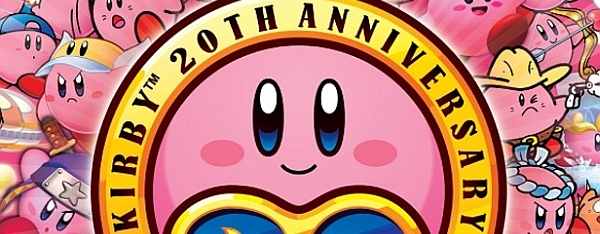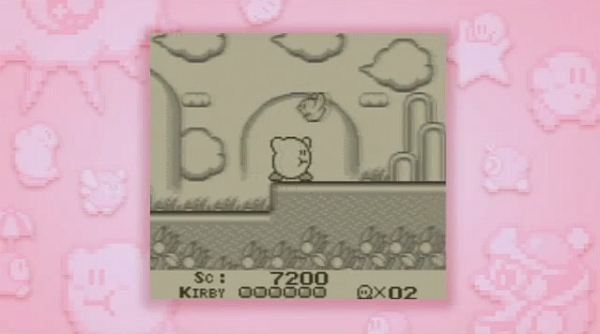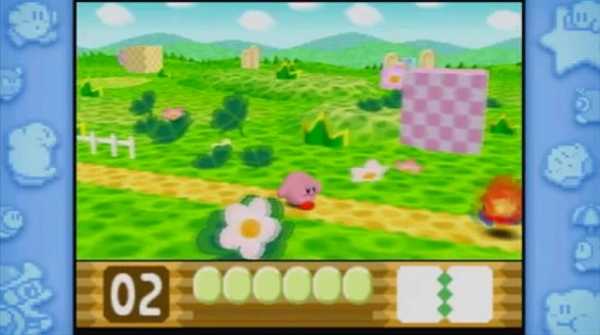
The pinkest, puffiest, suckiest, and blowiest gaming icon is finally celebrating his 20th birthday. Kirby’s Dream Collection brings together the first six games in the series, from the classic Game Boy titles up to Kirby 64. Kirby is one of gaming’s most recognizable icons – and he’s a platforming character from the company that’s arguably the king of platformers. Have the Kirby games withstood the test of time? And is this a fitting celebration for the powerhouse of pink?
Platforms: Wii
Publisher: Nintendo
Developer: HAL Laboratory, Nintendo
Genre: Puffball Platforming Compilation
Release Date: September 16, 2012
ESRB Rating: Everyone 10+
The first thing you’ll notice about the Dream Collection is its presentation. Nintendo is pulling out all of the stops for this one: the special edition of the game is packaged in a vibrant pink cardboard slipcase and the art is predictably pleasant. Various iterations of Kirby adorn the box along with enemies and allies from throughout the series. It really conveys that sense of celebration. The special edition also comes with an aptly named “Celebration Book” that details the history of Kirby and delivers the same sense of extravagance as the rest of the package. There’s a soundtrack CD included, too – which features compositions from throughout Kirby’s lifespan, plus a few surprises.
The game’s delightful spirit isn’t lost when it’s powered on, either. The playful opening cinematic, the recognizable musical cues – Kirby’s Dream Collection is a Kirby-centric nostalgia trip.
Players are presented with three options after the title screen: Challenge Stages, Classic Titles, and the Kirby Museum. Having played and completed four of the six classic titles featured here, I opted to explore the Challenge Stages and the museum before digging into any of the older games.
The Challenge Stages are short gauntlets, designed to test Kirby’s proficiency with a single one of his powers. The stages are littered with coins, enemies, gimmicks and, situations designed to take advantage of a particular copy ability. An ability which Kirby can neither remove nor replace during the course of the stage, by the way. Every enemy defeated and coin collected increases Kirby’s score and he’s tasked with completing the stages within a certain time limit. These stages are challenging, interesting, and fun. They aren’t, however, a novel concept. Though this collection of stages is presented in a new fashion and features new level design, it’s worth noting that the “Challenge Stages” are a concept recycled from Kirby’s Return to Dreamland. As such, I spent a short time with these before moving on to the Kirby Museum.
And this, sadly, is where the disappointment began to set in. The museum allows players to scroll through each Kirby game in the series – players can view a three dimensional rendering of the original box of the game, read a short two-to-three sentence blurb about it, read about a few facts that occurred during the year of the game’s release, and watch a short gameplay video accompanied by a scrolling, ticker-tape style sentence about the game. That’s it.

Now, don’t get me wrong – that’s certainly interesting. The problem here is that this was a seriously wasted opportunity. Think about it – this is one of Nintendo’s first official presentations of the history of one of gaming’s most iconic figures. This was a chance for gamers to hear about all of the things that went into the making of each game. There has to be a ton of pre-release, development material in Nintendo’s vault that wasn’t included here and would have been perfect.
I want a taste of that Nintendo charm – that essence of good game design and amazing presentation. Thankfully, that isn’t lost on this title – since it happens to bring together six of the best Kirby games in the series.
I think Kirby’s Dream Land (the Game Boy game that started it all) serves as a good metaphor for the Kirby series in general. Start out with the simple mechanics of sucking, blowing, and flying. Give the player a simple goal – get through the enemies and get to the boss – and work within those beautiful, creativity-inspiring limitations. The game is sweet, simple poetry – it is an ode to the suck and the blow. The simple, one-hit kill enemies litter the screen – sometimes randomly, sometimes in dazzling formation. The music is addictive, and the locales are surprising and somewhat spontaneous. One minute you’re on land at the beach, the next, you’re shot out of a whale’s blowhole and into the clouds.
There is some challenge. Is Whispy Woods about to kill me? How many traps will I fall for? I’ve died again, but I know I deserved it. There’s also variety. I pick up a power-up in Kirby’s Dreamland; Suddenly, I can spit fireballs. I pick up another power-up; I can’t stop flying and I’m battling against an airship. The Kirby games continue, each one expanding on those simple formulas little by little. I’m playing Kirby’s Adventure; I’m in full color, finally pink. Now I can copy the power of my foes. I can fight alongside my friends in Kirby Super Star and Kirby’s Dream Land 3. I’m playing Kirby 64 – suddenly, I’m in full 3D and I’m combining powers together. Each of the games included here builds on the franchise – takes inspiration from that basic design philosophy – builds it into something surprising, enjoyable, fun.

But there’s another, unavoidable side to that coin. The Celebration Booklet is adorned with gorgeous art and lists every Kirby game released – but one can’t help but notice the repetitions. Even though this is Nintendo’s first official Kirby compilation, the publisher has been remaking the character’s games for years. Kirby’s Nightmare in Dreamland, released for the Game Boy Advance, is nearly the same as Kirby’s Adventure. Kirby Super Star Ultra for the DS is exactly like Kirby Super Star with some new levels and enhancements. The Challenge Stages, while new in level design, are a concept lifted directly from Kirby’s Return to Dreamland. For a series so full of innovation, it’s a shame that those ideas were essentially recycled. And besides that, Kirby’s Return to Dreamland, while certainly enjoyable, didn’t strike me as being as… charming… as the earlier games in the series. It’s as if Kirby’s losing something.
There’s the lackluster presentation of games and information in the museum, the somewhat droll chamber music performance included on the disc (and, as a violist, I respect classical music. The video just lacked creativity), and the niggling fact that I’m still not sure how to get back to the title screen of the Game Boy titles. The collection feels somewhat rushed and it lacks creativity.
Kirby’s Dream Land is good. Kirby’s Adventure is good. All of the games included here – they’re undeniably good. They’re classics. They’re excellent. If you’ve never played a few of the games here and you like a good platformer, or a good video game, pick it up. If, however, you’re familiar with the titles in the series, you’ve played them all, you’ve beaten them all, you’ve gotten 100% on a few of them – you aren’t getting much here. It’s nice to have all of the games together in one neat little package – but that package was re-gifted and covered in last year’s wrapping paper. It’s the thought that counts – and the sum of the parts here does a good game make. Kirby could have just done with a better 20th birthday present.

Review Disclosure: A review copy of Kirby’s Dream Collection was provided by Nintendo for the purposes of this review.







